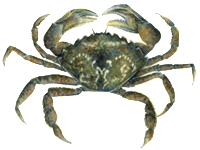Pathways and Support Systems
A recent bulletin from the Smithsonian Environmental Research Center recently listed the most common pathways for exotic invaders. Those pathways include:
- Aquaculture
- Aquarium
- Trade
- Boats and Ships
- Channels, canals, locks
- Live bait
- Nursery industry
- Scientific research, schools
- Fisheries enhancement
For world-wide marine ecosystems, ballast water from tankers remains the main vector for exotic introductions. Every year, 16 billion tonnes of ballast water is shipped around the globe. Fully 3,000 exotic species are in inter-continental transit-daily.
Scientists also tell us that aquaculture is a perfect host for non-indigenous species. Aquaculture activities add nutrients to water, fuelling eutrophication and red tides, which kill fish and mammals.
 |
|
Copyright Brenda Guild Gillespie 1999
|
The aquaculture industry has also introduced a species of salmon that is exotic to the West Coast-the Atlantic salmon.
The Atlantic salmon is favoured over Pacific salmon because Atlantics grow faster. Atlantic salmon now constitute about 80 percentof B.C.'s total farm-fish production.
The potential impacts of Atlantic salmon on native salmon remain unclear. We do know, however, that many Atlantic salmon escape each year from fish farms, including nearly 100,000 between 1988 and 1995. We also know that (despite salmon farming industry assurances that it couldn't happen) Atlantic salmon reproduced the last 2 years in Vancouver Island's Tsitika River, that Atlantics eat food otherwise eaten by native fish, and that it costs us $35,000/year to (inadequately) monitor Atlantics in a few Vancouver Island rivers.
